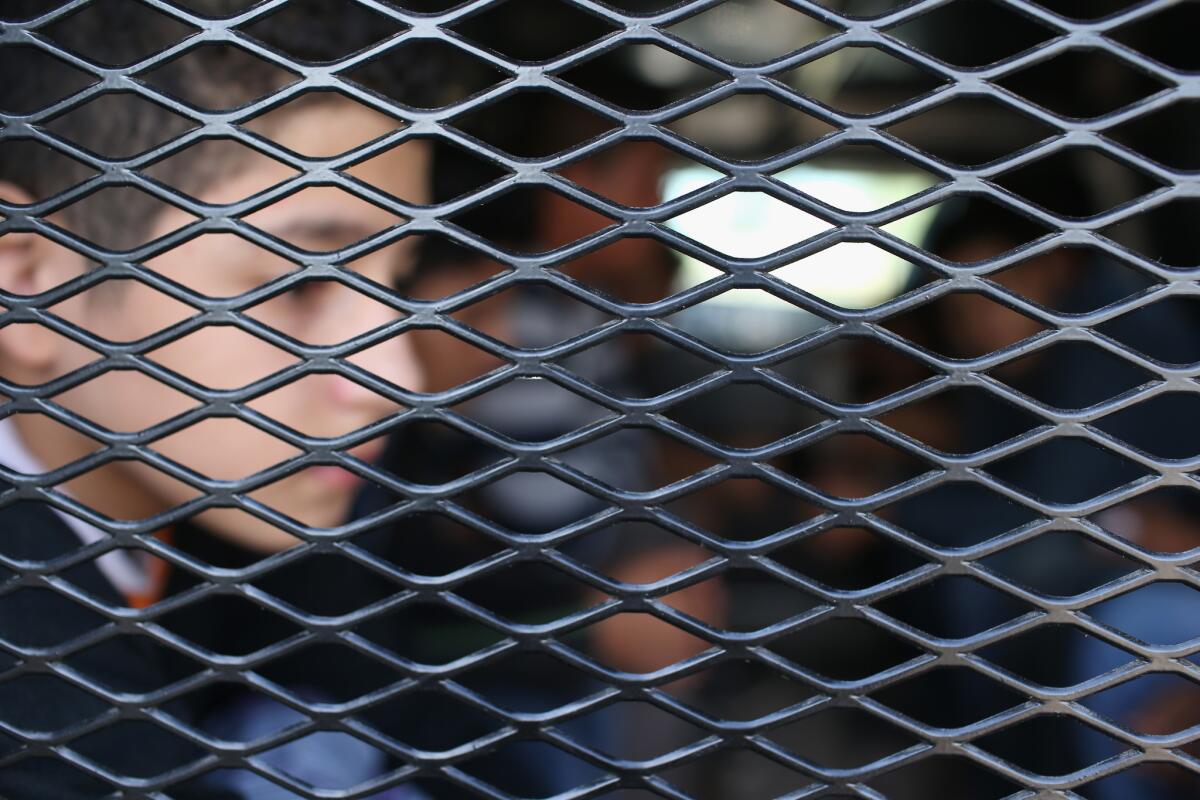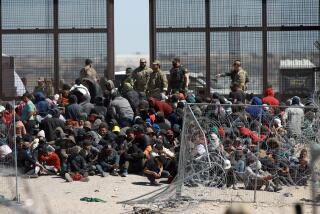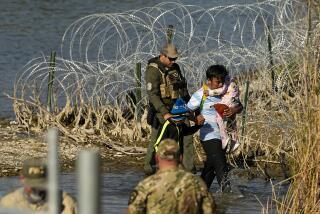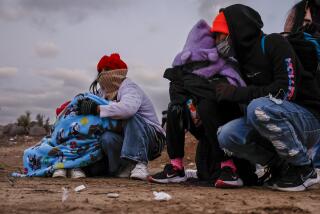As federal officials open shelters for migrant children, Texas fortifies its border

Central American immigrants wait to be transported after turning themselves in to U.S. Border Patrol agents near Rio Grande City, Texas.
Texas Gov. Greg Abbott announced Tuesday that he is extending the deployment of National Guard troops at the southern border to combat the dramatic increase in young migrants caught crossing into the United States.
The governor also ordered the Texas Department of Public Safety to increase the number of boats and tactical officers on the Rio Grande and stepped up aerial observation missions. He said that 100 troopers have been deployed and that 250 more will be sent “as fast as their training can be completed.”
Abbott’s offensive came as federal officials were showing off new facilities designed to aid the young people who are being intercepted as they cross the border. Many are fleeing the violence in Central America.
Abbott said he warned Homeland Security Secretary Jeh Johnson about the “significant increase” in young border crossers in September and asked for his help to keep the situation “from escalating into an uncontrollable crisis.”
But the governor said that help never arrived.
“Despite the warning — followed by a phone discussion about the matter — my request for more Border Patrol agents and strategic resources to secure the border were ignored,” Abbott said in a statement.
Homeland Security spokeswoman Marsha Catron said officials have “noted an increase in the number of unaccompanied children and family units apprehended along the Southwest border from Central America.”
“We have been closely monitoring these current trends and coordinating across the whole of government to ensure an effective response to changes in migration flows,” Catron said.

Central American immigrants are among the thousands of children who come north to escape the violence of Central America.
She emphasized that while the number of youths and families crossing the border has increased recently, the total number of people caught has reached a historic low, about 330,000 for the fiscal year that ended in September.
A thousand National Guard troops were deployed to the border in July 2014 by then-Texas Gov. Rick Perry amid a surge of migrant children and families from Central America. The troops’ ranks dwindled to several hundred as the number of immigrants arriving ebbed this year.
Now, more are arriving at the border again. Abbott said that during the last two months, the number of unaccompanied children caught crossing the border was two to three times higher than last year at this time. Many are fleeing violence in El Salvador, Guatemala and Honduras.
The number of children caught along a remote stretch of the west Texas border near Big Bend National Park has increased almost tenfold this fall, Abbott said — a sign, according to some experts, of smugglers taking new routes. But the influx of children this fall remained concentrated in the Rio Grande Valley, where the number of migrants intercepted nearly doubled to 6,465.
When the children are caught by the Border Patrol, by law they must be turned over within 72 hours to the Department of Health and Human Services, which runs shelters for immigrant children and families. Children are held at the shelters until they can be placed with parents, relatives or other sponsors while their immigration cases are pending.
The secretary of Health and Human Services has asked the Pentagon to line up 5,000 shelter beds for the youths. During last year’s surge, the military opened emergency shelters to house the migrants at bases in Oxnard, San Antonio and Ft. Sill, Okla.
Last week, federal officials announced that they would be opening emergency shelters for 1,400 unaccompanied children — 400 in California and 1,000 in Texas. That’s in addition to the military request and 8,400 shelter beds already available nationwide, many along the border.
In north Texas, two shelters opened last week to house 800 children at a ranch and an Assembly of God church camp.
Federal officials were hosting a tour Tuesday afternoon of the shelter at Lakeview Camp and Retreat Center in Waxahachie, about 35 miles south of Dallas, an area known for sprawling fields of bluebonnets. The camp’s executive director, Jaroy Carpenter, posted a letter on its website saying he had readied a team of 200 to work with the children, ages 12 to 18.
“While here, these students will experience recreation, education, church services and other typical camp programming,” Carpenter said.
Some local officials and residents have expressed concern about security at the shelter, as they have in other parts of Texas where shelters have opened. In Dallas, a backlash led officials to scrap plans to shelter 2,000 of the youths last year.
The shelters are not secure facilities, and dozens walked away from them last year, according to federal records.
Ellis County Commissioner Paul Perry questioned why he was given only 48 hours’ notice before the Waxahachie shelter opened.
“I still would have opposed it, but they wouldn’t have received the same level of emotional response,” Perry said.
He said local opposition reached a “fever pitch” this week, with rumors flying that “could have been nipped in the bud had they given us more lead time.”
The commissioner said he is not opposed to aiding Central America. His daughter is preparing for a 10-month mission trip there to teach English at an orphanage. What he resents, he says, is “this being dropped on our heads in a suburban, somewhat rural county with no notice.”
He toured the shelter Monday, where he said he saw mostly adolescent boys in clean, well-lighted facilities with security personnel but no security fence.
“The security is as good as it’s going to be for a shelter that’s not designed to be secure,” said Perry, a former magistrate. “They claim they’ve screened these folks, and I’m sure the average one is not a problem, but we really don’t know the backgrounds of these people.”
molly.hennessy-fiske@latimes.com
@mollyhf
More to Read
Start your day right
Sign up for Essential California for news, features and recommendations from the L.A. Times and beyond in your inbox six days a week.
You may occasionally receive promotional content from the Los Angeles Times.







